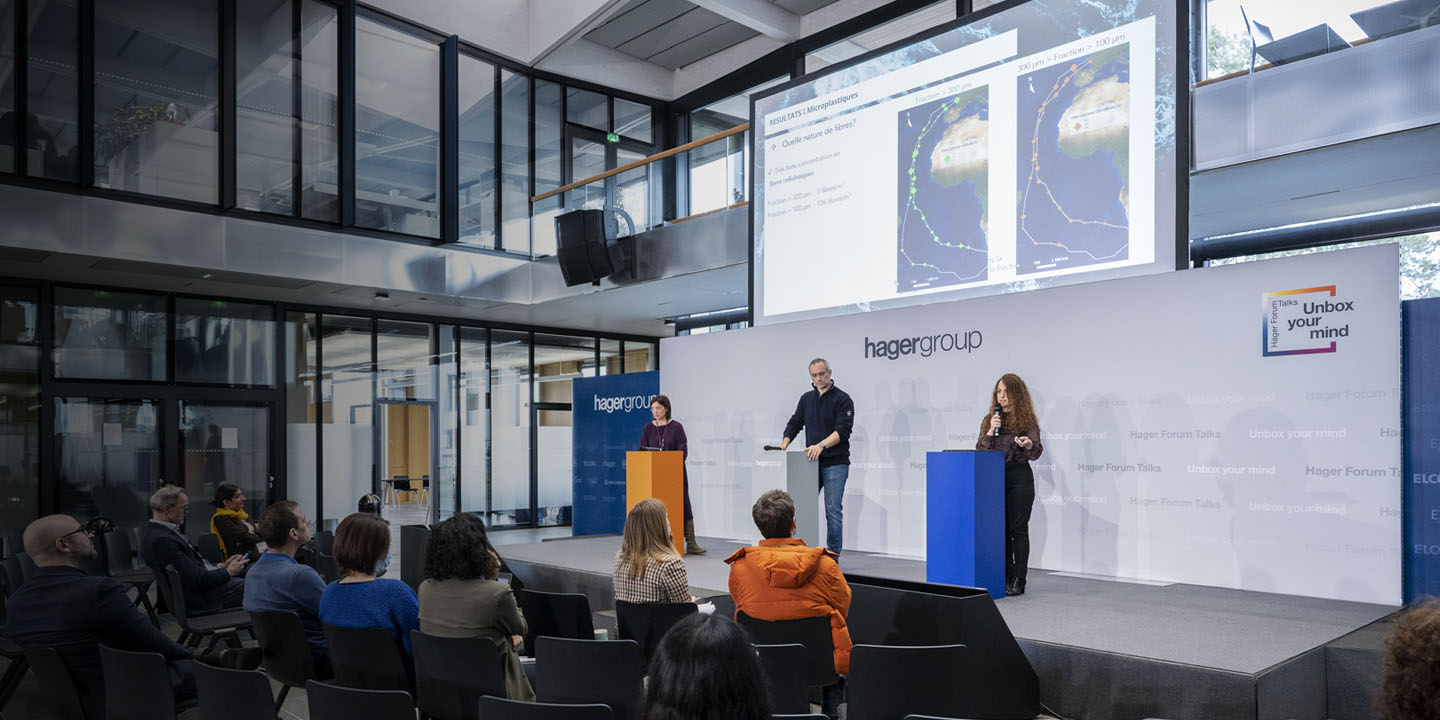03.02.2023
The Ocean Calling project
Hager Group and Fabrice Amedeo commit to research into microplastic marine pollution
Hager Group has been a partner of Fabrice Amedeo's ocean racing project for two years. The yachtsman has installed a microplastic sensor to measure ocean pollution on his IMOCA boat, which he will be racing in the next Vendée Globe. Scientists from IFREMER and the University of Bordeaux, who were present at the Hager Group headquarters in Obernai on Monday 30th January, presented the results of the 2020 measurement campaign in the Atlantic. The results show that the more detailed the analysis, the more microparticles are found.
It is an incremental study looking at ever smaller microparticles floating in the Atlantic. The microplastics sensor on board the IMOCA Nexans - Art et Fenêtres has three filters trapping three different sizes of microplastics: 300 microns, 100 microns and 30 microns. Whilst racing, Amedeo changes these filters every 24 hours. 53 samples were taken in the Atlantic Ocean during the last Vendée Globe. The first results of the analysis of the 300 µm filters were unveiled in Marseilles in the spring of 2022. They showed that the surface waters of the Atlantic Ocean are twice as polluted by cellulose fibres as by microplastics. All the findings of this study are available here.
"This Ocean Calling project is very close to my heart. In 15 years of ocean racing, I have really witnessed the degradation of the state of our oceans, and I can no longer imagine sailing them without getting involved. We will be launching a new boat at the end of spring, equipped with all the oceanographic sensors. Our ambition is to continue the measurement campaigns in the Atlantic with four transatlantic races over the next 18 months, and then go and collect precious data in the Southern Ocean during the 2024 Vendée Globe."
Fabrice Amedeo, Nexans Skipper, Arts and Windows.
"If Hager Group supports scientific research as part of our partnership with Fabrice Amedeo but is also committed to the Ocean Calling investment fund, it is because as a family business, preserving nature is important to us. Reducing our environmental impact and preserving it for future generations are at the heart of our concerns.
Daniel Hager, CEO Hager Group
The analyses of the samples taken from the 100 µm mesh filters have just been concluded by the scientific teams. The aim now is to discover how the smaller fragments are distributed in the water column.
A greater concentration of microplastics and cellulose fibres
This new spectroscopic analysis shows a greater presence of cellulose fibres: they are 40 times more concentrated on the 100 µm sieves than on the 300 µm sieves, with a distribution in the water column that is almost equivalent to that of the microplastics. "Despite the hydrodynamic differences between their morphologies, microplastics and fibres undergo a similar dynamic dispersion in the open ocean," explains Christophe Maes, IRD research officer, Lab.
The analysis also shows that a greater variety of plastics is detected on 100 µm sieves than on 300 micron sieves. The microplastic particles most present in the filters are polyethylene terephthalate (PET: 18%) and polyethylene (PE: 16%).
The quantity of microplastics increases with the decrease in size: 100% of the samples from 100 µm sieves contain microplastics compared to 64% for 300 µm sieves. The average concentration is 38 particles/m3 (34 times greater than that of particles larger than 300 µm). This can be explained by a faster fragmentation of certain types of plastic into very small particles due to biological, chemical and physical processes: abrasion, UV action or biodegradation.
Cellulose fibres, which were twice as present as plastic fragments in the 300 µm filters, have seen their proportion decrease in the 100 µm filters, representing 54%. This ratio could be reversed at the 30 µm level according to the scientists who will be studying this size of microparticles over the next few months.
A confirmed difference between North and South
This second wave of offshore surface water studies confirms a real difference between the South Atlantic and the North Atlantic. Indeed, the South Atlantic seems to be slightly less contaminated by microplastics, which raises questions about the internal dynamics of the subtropical oceanic gyre (around 30°S). Samples taken on 30 µm filters as well as those taken during the last Transat Jacques Vabre between Le Havre and Brazil will allow us to better map the microplastic pollution of the North Atlantic and to refine our understanding of the difference in concentration between the South and the North.
This large-scale project represents an unprecedented opportunity for the scientific community. It will enable the collection and analysis of microplastics of different size classes present in surface ocean waters for which little data is currently available, and thus enable the identification of the main sources of plastic pollution.
-
About Advizeo
Hager Group is a leading provider of solutions and services for electrical installations in residential, commercial and industrial buildings with 12,100 employees generating 2.6 billion Euros in sales.
Components and solutions are produced at 22 locations around the globe and are distributed to customers in more than 100 countries. Hager Group is an international independent family-owned and run company headquartered in Germany.
One of the industry’s innovation leaders, Hager Group aims at sustainably shaping the electrical world of tomorrow and play a leading role in the field of energy management and distribution. Customers rely on the group’s safe and simple products and solutions which range from energy distribution, cable management and wiring accessories to building automation, security systems and energy management.


